
|
|

February 10, 2006
Towers from the North Country: The Big Trip, 2005
Part I: Minneapolis-St. Paul, round one
By SCOTT FYBUSH
Once every year or so, your editor gets together with other similarly radio-crazed folk for an event that's become known as "The Big Trip" - a week (or more) of dawn-to-dusk (and sometimes beyond) traveling in search of interesting new sites to showcase here on Tower Site of the Week, in the Tower Site Calendar, and so on. It's a chance for us to meet people we've only corresponded with via e-mail, and to gather airchecks and legal IDs for our new content partners at www.tophour.net, too. (Never been there? If you like legal IDs, what are you waiting for?)
The "Big Trip" thing began in 1998 with a week in the Canadian Maritimes, and has continued in subsequent years with trips to northern Ontario in 1999, "The Big Trip" from New England to the Dakotas in 2001, Tennessee/Georgia/Alabama in 2002 and the Carolinas in 2003.
As we made our travel plans for 2005, we focused on one part of the country that we'd missed in previous trips: Minnesota and Wisconsin. On Thursday, August 11, we kicked off a ten-day excursion designed to take in as much of both states' radio scenery as possible (and to honor a non-radio milestone as well - but we'll get there in our third installment.)
And we began in the logical place to begin - the region's largest market, the Twin Cities of Minneapolis-St. Paul.
Setting off from Fort Wayne with Indiana Radio Watch editor Blaine Thompson, we met up with regular "Big Trip" colleague Garrett Wollman (of the Archives @ BostonRadio.org) at O'Hare - then spent way too long at MSP airport waiting for luggage and a long rental-car line. And that, in turn, left us a little behind schedule as we set off to the south for our first stop, a visit to Salem's Twin Cities cluster and to chief engineer Scott Todd, known to us from DX and engineering circles.
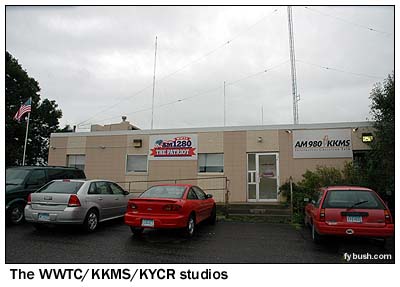 |
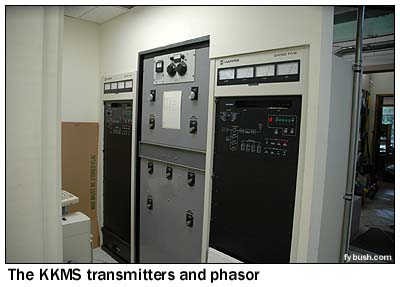
|
Salem has three stations in the market - religious talker KKMS (980 Richfield) and secular talkers WWTC (1280 Minneapolis) and KYCR (1570 Golden Valley) - all sharing studios at the KKMS transmitter site in Eagan, a few miles south of the airport. (The facility was built for 980 in its long-ago days as WPBC; in later years, 980 and its erstwhile sister station at 101.3 would become "U100," WYOO AM-FM, and still later, after the FM was sold and became KDWB-FM, the AM ended up as WAYL, paired with beautiful music WAYL-FM on 93.7.)
After a quick tour of the facility and a look out the back window at the three-tower array, we head off (following Scott) to the west side of town, through rush-hour traffic, to the Minneapolis suburb of St. Louis Park and the four-tower site shared by WWTC and KYCR.
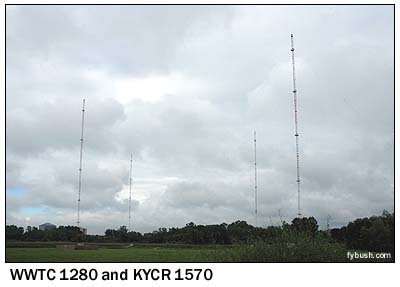 |
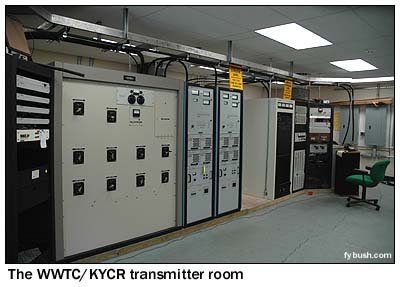
|
KYCR is a relatively recent arrival here; it had spent most of its life (as ethnic broadcaster KUXL) at another one-tower site nearby before Salem acquired it. The heritage of this site off Cedar Lake Road, though, is on the 1280 side, where this site was built in the early sixties for the station then known as WTCN.
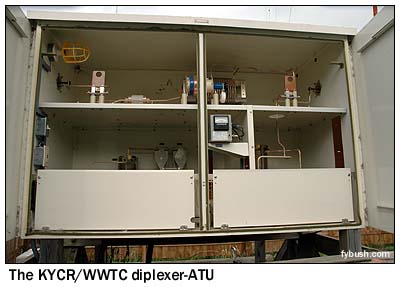 There's
a great book called "Fiasco at 1280" that tells the
story of the next three decades or so in the life of this station,
which became WWTC when it was sold away from WTCN-TV (channel
11, now KARE), and which then went through a whole roller-coaster
of owners, formats and studios before ending up in the mid-nineties
as the flagship of kiddie network "Radio AAHS."
There's
a great book called "Fiasco at 1280" that tells the
story of the next three decades or so in the life of this station,
which became WWTC when it was sold away from WTCN-TV (channel
11, now KARE), and which then went through a whole roller-coaster
of owners, formats and studios before ending up in the mid-nineties
as the flagship of kiddie network "Radio AAHS."
AAHS didn't work, either, in the end, and when it folded, WWTC found conservative talk as "The Patriot," which has turned out to be the most stable format the station's had in a very long time. (So much so that when KYCR came into the fold, it became "The Patriot II," offering a time-shifted version of the WWTC schedule.)
Scott's put together a nice-looking transmitter site out here. A long row of transmitters includes KYCR's Gates Five (out of frame to the left), the WWTC phasor, a pair of Nautels for WWTC and a backup Gates Five as well.
Out in the field, KYCR (which runs 3.8 kW day/230 watts night, non-directional) is simply diplexed into the ATU of one of the WWTC towers.
From here, just a few hours into our Big Trip, we head off to what will turn out to be one of the absolute highlights of the trip - the nearby Pavek Museum of Broadcasting, tucked away in an inconspicuous industrial building just off Highway 100.
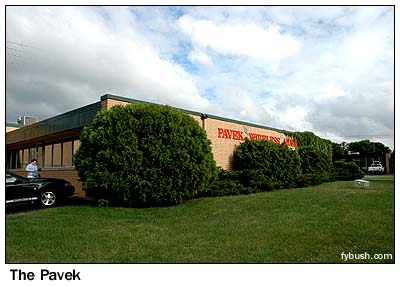
|
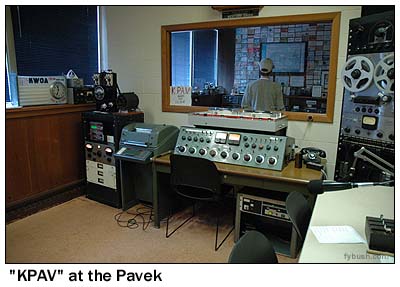
|
We'd heard about the Pavek over the years, but the descriptions never quite did justice to the sheer magnitude of the collection, which began with Joseph Pavek's assemblage of transmitters, receivers, recording gear and more from the early twentieth century.
Before we begin drooling over the magnificent assemblage of radio history (all the way back to spark-gap transmitters and such), we detour to the two-room studio setup shown above, where schoolkids from all over the Twin Cities area come in to learn about old-time radio and to produce their own radio shows at the museum's "KPAV" radio.
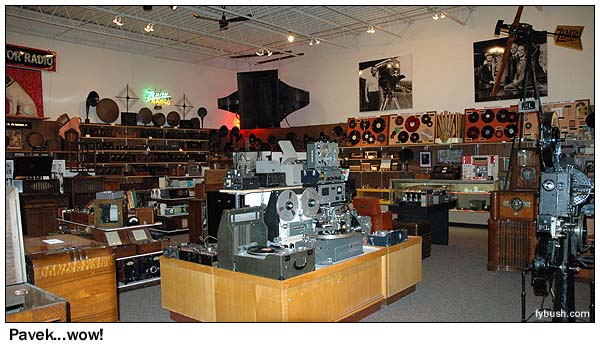
From here, the collection continues chronologically, entering a huge gallery (shown above and at left, below) with sections devoted to radio receivers, microphones, antennas, TVs, recording technology, a working Theremin, and the remarkable Jack Mullin collection.
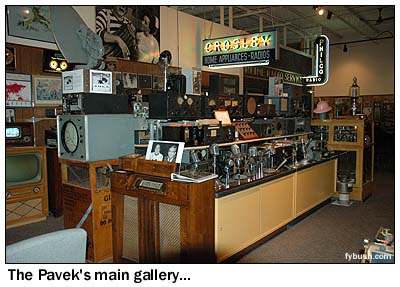
|
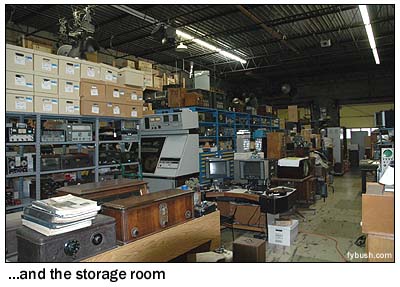
|
Mullin was the Army engineer who discovered the German "magnetofon" technology during World War II, returning home after the war with German-made tape heads and 50 reels of tape that were soon combined with home-built transports and electronics to create the first tape recorders used in the U.S.
Working with a small northern California company called Ampex, Mullin soon made audiotape a commercially viable medium, putting it to use initially on the Bing Crosby show, allowing Crosby (who hated live broadcasts) to record and edit his shows at leisure, without the tradeoffs in sound quality from the earlier transcription discs.
Among the gems in the Pavek collection are the original German magnetofon that was used for the first Crosby broadcasts - with a reel of the original German tape still on it, still in working order (and sounding fantastic through the big theater speaker in the corner of the gallery) - and one of Mullin's first Ampex 200 machines that quickly succeeded the German units.
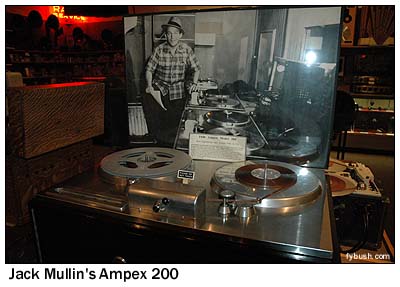
|
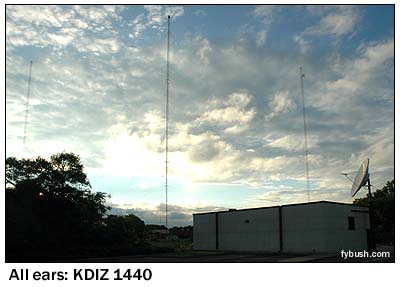
|
The sun is almost down by the time we leave the Pavek (with dreams of returning for a longer visit sometime soon), leaving time for just one more stop a few miles to the north. Alongside Highway 100 just north of I-394 is the three-tower site of KDIZ, Golden Valley (1440), the area's Radio Disney affiliate. This was the old KQRS(AM), survived on the FM dial by rocker KQRS-FM at 92.5.
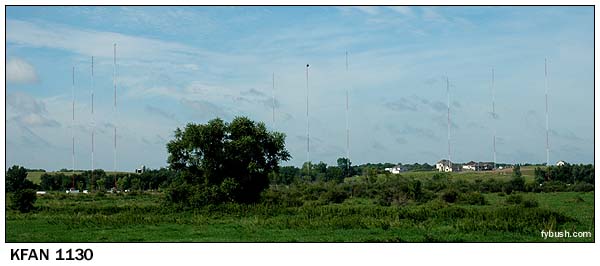
The next morning, the clouds have given way to blue skies, and day two of our Big Trip begins far south of the metro, at the "new" site of KFAN 1130 in Credit River, Minnesota. This 50 kW day/25 kW night facility now does sports for Clear Channel, as the flagship of the "FAN Radio Network" that stretches across Minnesota and into the Dakotas - but back in the day, 1130 was the top-40 giant WDGY, with nine towers much closer to town in Bloomington, and former CE Aaron White has created one heck of a web site with pictures of the old site (giant lighted sign and all) and the new site.
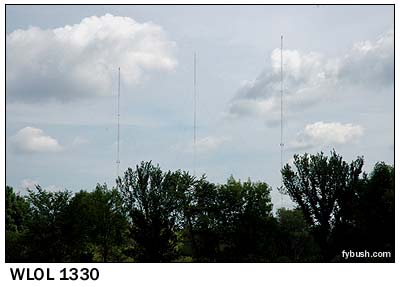
|
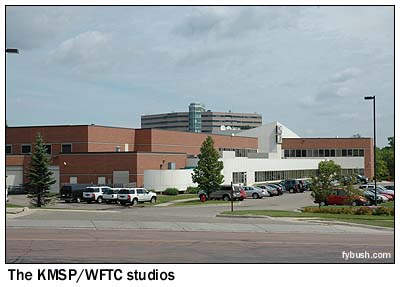
|
Heading north again, our route takes us around the bottom of the market on Highway 13, passing as we go the three tower site in Savage that's home to WLOL, Minneapolis (1330). This station is back to its heritage calls after many years under other names - first as Minnesota Public Radio's news-talk KSJN(AM)/KNOW(FM), then as a commercial all-newser, WMNN, operated by a for-profit subsidiary of MPR (ironically enough, that move came after MPR acquired a second FM in the Twin Cities, none other than WLOL-FM at 99.5. 99.5 took the classical format and KSJN calls that had been on MPR's original 91.1 facility, 91.1 became news-talk KNOW, and that freed up 1330 to go commercial). A year or so ago, MPR unloaded the 1330 facility, which reclaimed the WLOL ("Land of Lakes") calls and took on Starboard's "Relevant Radio" Catholic format.
Moving north and west, we come to Eden Prairie, southwest of Minneapolis, and it's here that we find the studios of Fox's duopoly, KMSP (Channel 9) and WFTC (Channel 29), with Fox on 9 and UPN on 29 (little did we know what was in store for that network last summer.)
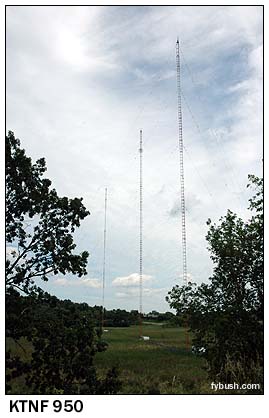
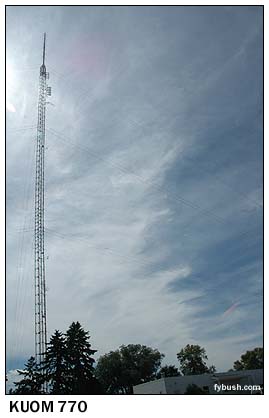 From there, we can
look over to the three-tower array of KTNF, St. Louis Park (950),
the Twin Cities' Air America outlet. How local is the ownership?
So local that owner Janet Robert comes out to ask what we're
up to and to say hello...
From there, we can
look over to the three-tower array of KTNF, St. Louis Park (950),
the Twin Cities' Air America outlet. How local is the ownership?
So local that owner Janet Robert comes out to ask what we're
up to and to say hello...
(This station, too, has gone through plenty of calls and owners since its original incarnation as KRSI; most recently, it was Infinity's second AM in the market, a sister to giant WCCO under the calls KCCO. Its studios out by the tower on Valley View Road still bear the sign from the old smooth jazz format on its erstwhile FM sister at 104.1, which is now "Jack FM" under the calls KZJK. We'll catch up with it again later on in our tour...)
And after a stop for lunch, we have one more Minneapolis site to see before heading north for the weekend. KUOM (770) is one of the oldest noncommercial licenses in the country, and like most of those very early land-grant university educational stations, it ended up on a daytime-only facility as the Federal Radio Commission (and later the FCC) organized the AM band. Unlike most of those stations, KUOM ended up not as an NPR outlet but as a student-run station, and today's "Radio K" plays modern rock and - even now - signs off at sunset to make room for WABC.
"Radio K" has found a way around that, though - they partnered up with class D high-school station KDXL (106.5) in St. Louis Park for share-time operation, and so KUOM-FM on 106.5 became one of the most recent class D licenses to be issued by the FCC, just a couple of years ago. It now has translators to carry its signal deeper into Minneapolis and St. Paul, and one of them - W264BR (100.7) - is on the AM tower adjacent to the University of Minnesota golf course on Roselawn Avenue, a few miles east of downtown Minneapolis.
This tower appears to have gone up in the early fifties with the primary purpose of accommodating new public TV station KTCA (Channel 2), and the old channel 2 batwing antenna is still up there at the top. (I think one of the sets of FM bays on the side is, or was, an aux for Minnesota Public Radio's 91.1, too.)
So where's channel 2 now - and the rest of the market's FM and TV? Where, for that matter, are WCCO and KSTP? And isn't there a state capital to be visited somewhere around here? Yes, to all counts - but on this Friday afternoon, we're headed north instead, for a detour to Duluth and International Falls. We'll get back to Minneapolis and St. Paul in a couple of installments, we promise!
- Previous Site of the Week: KBLA, Santa Monica/Los Angeles
- Next Week: The Minnesota/Wisconsin Big Trip, Part II: Duluth
- Site of the Week INDEX!
- How can you help support Site of the Week? Click here!
- Submit your suggestions for a future Site of the Week!
